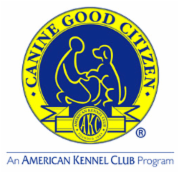What Is It? 
AKC Canine Good Citizen (CGC) Program
At the American Kennel Club, we’re not just champion dogs, we’re the dogs’ champion. We believe that all dogs deserve training and a responsible owner and our goal is to reward responsible dog ownership.
The AKC’s Canine Good Citizen Program is designed to recognize dogs who have good manners at home and in the community. This rapidly growing nationally recognized program stresses responsible dog ownership for owners and basic training and good manners for dogs. All dogs who pass the 10 step CGC test may receive a certificate from the American Kennel Club.
The Benefits of Training
The AKC CGC Program provides an excellent foundation for training in other fun activities such as Rally, Obedience, and Agility and results in a well-mannered dog who is a joy to live with. Some therapy dog groups require passing the CGC Test as a prerequisite, some insurance companies recommend CGC training, and an increasing number of apartments and condos are requiring CGC training for resident dogs.
How It Works
You can attend a basic training or CGC class to teach
your dog the CGC behaviors, or if you have the skills and
knowledge, you can teach your dog the CGC skills.
When your dog is ready, you’ll sign up for a CGC test administered by an AKC Approved CGC Evaluator.
Tests are held at AKC dog shows, at some training
classes, at a number of pet super stores, or some evaluators
will make an appointment to test your dog.
When your dog passes the CGC test, the evaluator will
give you the paperwork to send to AKC to request the
CGC certificate.
________________________________________________________________
The CGC TEST consists of 10 skills needed by all well-mannered dogs. All of the exercises are done on a leash.
Test 1: Accepting a friendly stranger
The dog will allow a friendly stranger to approach it and speak to the
handler in a natural, everyday situation.
Test 2: Sitting politely for petting
The dog will allow a friendly stranger to pet it while it is out with its
handler.
Test 3: Appearance and grooming
The dog will welcome being groomed and examined and will permit
someone, such as a veterinarian, groomer or friend of the owner, to do so.
Test 4: Out for a walk (walking on a loose lead)
The handler/dog team will take a short “walk” to show that the dog is in
control while walking on a leash.
Test 5: Walking through a crowd
The dog and handler walk around and pass close to several people (at least
three) to demonstrate that the dog can move about politely in pedestrian
traffic and is under control in public places.
Test 6: Sit and down on command and Staying in place
The dog will respond to the handler’s commands to 1) sit, 2) down
and will 3) remain in the place commanded by the handler (sit or down
position, whichever the handler prefers).
Test 7: Coming when called
The dog will come when called by the handler. The handler will walk
10 feet from the dog, turn to face the dog, and call the dog.
Test 8: Reaction to another dog
To demonstrate that the dog can behave politely around other dogs,
two handlers and their dogs approach each other from a distance of about
20 feet, stop, shake hands and exchange pleasantries, and continue on for
about 10 feet.
Test 9: Reaction to distraction
To demonstrate the dog is confident when faced with common distracting
situations, the evaluator will select and present two distractions. Examples
of distractions include dropping a chair, rolling a crate dolly past the dog,
having a jogger run in front of the dog, or dropping a crutch or cane.
Test 10: Supervised separation
This test demonstrates that a dog can be left with a trusted person, if
necessary, and will maintain training and good manners. Evaluators are
encouraged to say something like, “Would you like me to watch your
dog?” and then take hold of the dog’s leash. The owner will go out of sight
for three minutes.
Equipment
You’ll need to bring your dog’s brush or comb to the CGC test. In the
CGC test, dogs must wear a buckle collar or slip collar.
For details regarding equipment, expanded descriptions of the exercises
above, and how the CGC Test is administered, see:
http://www.akc.org/events/cgc/training_testing.cfm
Training Classes are available
For more Information on Training classes for the AKC Canine Good Citizen Program
If you would like to take the AKC Canine Good Citizen Test. Call for the next Testing Schedule
Call 570-486-3734